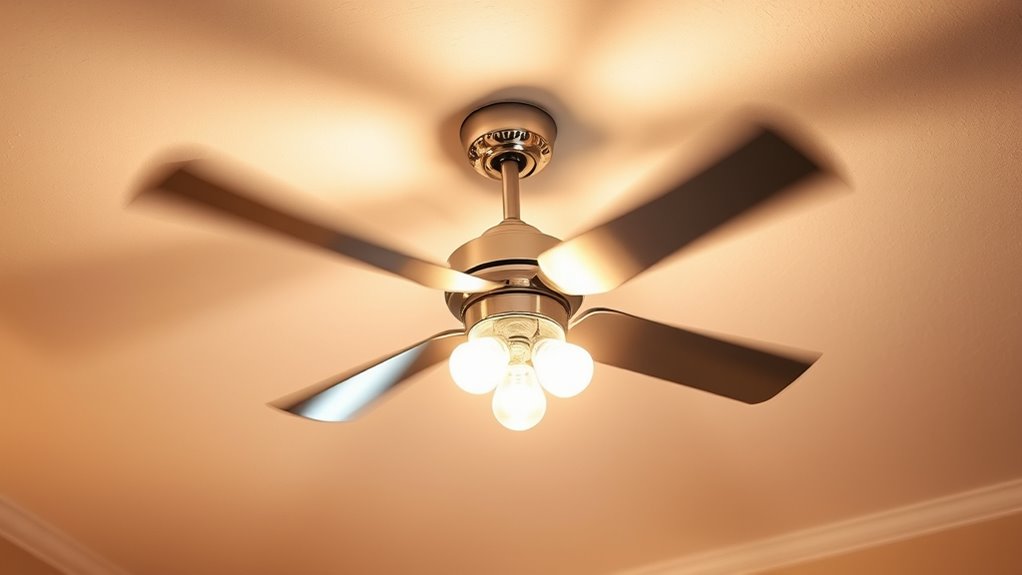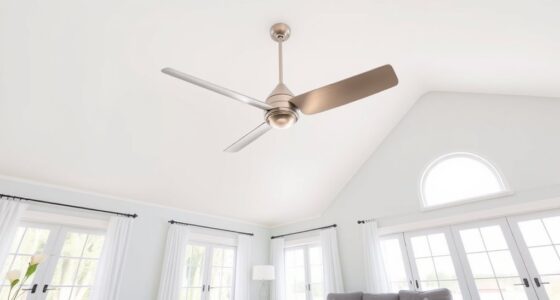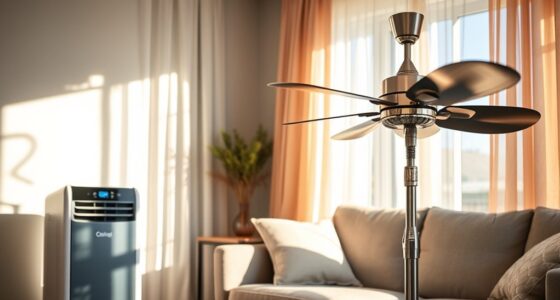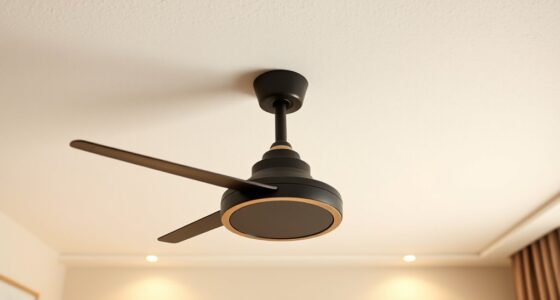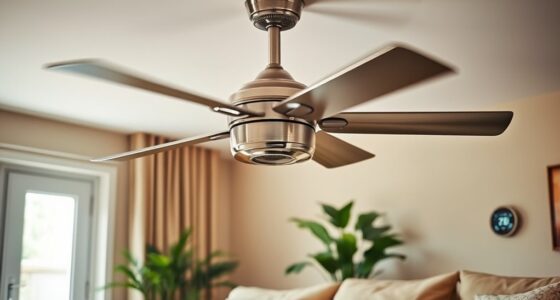Ceiling fans are a cost-effective way to improve your home’s comfort and lower energy bills when used correctly alongside solar panels and insulation. They help circulate air, reduce reliance on AC, and can even push warm air down in winter. By turning fans off when rooms are unoccupied and setting the right thermostats, you maximize savings. To uncover how combining these strategies boosts efficiency, explore the details that follow.
Key Takeaways
- Ceiling fans use minimal electricity, making them a cost-effective way to improve home comfort and reduce energy bills.
- When used with solar panels and proper insulation, fans significantly lower reliance on high-energy HVAC systems.
- Properly operating fans, such as reversing in winter and turning off when unoccupied, maximizes energy savings.
- Fans help circulate air efficiently, allowing higher thermostat settings on air conditioners and reducing energy consumption.
- Misconceptions about fans being energy-intensive are false; they are an energy-efficient addition to home cooling and heating strategies.
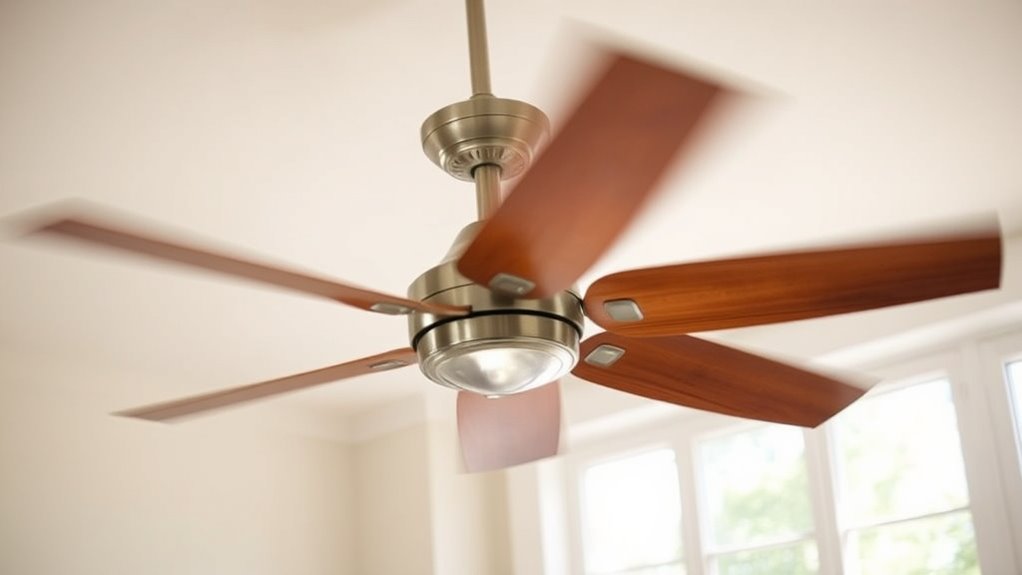
Have you ever wondered how ceiling fans can help you save energy and reduce your utility bills? It’s a common question, especially when you’re trying to cut costs while maintaining a comfortable home. The truth is, ceiling fans are often misunderstood; some see them as energy consumers, while others recognize their potential to boost efficiency. When used correctly, they can complement other energy-saving strategies like installing solar panels and improving insulation techniques. Together, these measures create an effective system for lowering your overall energy consumption.
Ceiling fans work by circulating air, which helps you feel cooler in summer and warmer in winter. During hot months, a fan creates a breeze that cools your skin, making you less reliant on your air conditioner. This means you can set your AC thermostat higher without sacrificing comfort, markedly reducing electricity use. In winter, reversing the fan’s direction pushes warm air down from the ceiling, helping your heating system work less. This simple switch can lead to noticeable savings on your heating bills. However, fans only save energy when they’re used wisely—running them constantly or forgetting to turn them off when you’re out won’t do you any favors.
Pairing ceiling fans with solar panels enhances these savings. Solar panels generate clean energy from sunlight, which can power your fans directly or offset the electricity used for other appliances. When your home is equipped with solar, running ceiling fans becomes even more cost-effective because you’re relying less on grid electricity. Additionally, proper insulation techniques are essential. Well-insulated walls, attics, and floors keep the cool or warm air inside longer, reducing the workload on your heating and cooling systems. When your home maintains a stable temperature, your fans don’t have to work as hard, further cutting energy costs. Combining insulation improvements with ceiling fan use maximizes your home’s energy efficiency, creating a comfortable environment while keeping bills in check.
Some skeptics argue that ceiling fans just add to your energy bill, but they overlook the bigger picture. When used alongside solar panels and proper insulation, fans become a indispensable part of a holistic approach to energy savings. They help you reduce reliance on high-energy systems, and their low power consumption makes them a smart choice. Remember, the key isn’t just in running a fan; it’s in using it smartly—turning it off when you leave a room and adjusting settings based on your comfort level. When you combine these practices, ceiling fans aren’t just myth-busting energy savers—they’re an effective, affordable way to trim your utility bills while maintaining a cozy home environment.
Frequently Asked Questions
Do Ceiling Fans Really Reduce Overall Energy Bills?
You might wonder if ceiling fans really cut your energy bills. In a cost comparison, they often use less electricity than air conditioning, helping you save money. Plus, their environmental impact is lower because they reduce energy consumption. When used properly, especially with your AC or heating, ceiling fans boost efficiency and comfort, making them a smart choice for lowering costs and protecting the planet.
Can Ceiling Fans Be Used Effectively in Winter?
Imagine turning your ceiling fan on in winter and feeling surprisingly cozy—sounds like a coincidence, right? Actually, with proper ceiling fan placement, you can use it to improve winter heating efficiency. Running fans clockwise helps circulate warm air near the ceiling, distributing heat more evenly. This trick reduces your reliance on your heater, saving energy and money while keeping your space comfortably warm during winter months.
What Is the Typical Lifespan of a Ceiling Fan?
You might wonder about your ceiling fan’s lifespan. Typically, a ceiling fan lasts around 10 to 15 years with proper maintenance. Fan motor longevity depends on usage and quality, while blade durability is influenced by materials and care. Regular cleaning and ensuring the fan isn’t overloaded can extend its life. Keep an eye on noise or wobbling, which signals it’s time for maintenance or replacement.
Are Energy-Efficient Ceiling Fans Worth the Investment?
You’ll find that energy-efficient ceiling fans are worth the investment because they improve lighting efficiency and reduce noise levels, making your space more comfortable. These fans use less electricity, helping you save on energy bills over time. Plus, their quieter operation means less disturbance. So, if you’re looking to cut costs and enhance comfort, upgrading to an energy-efficient ceiling fan is a smart choice for your home.
How Do Ceiling Fans Compare to Air Conditioning in Savings?
When comparing ceiling fans to air conditioning, you’ll find fans save more energy, especially with humidity control and lower noise levels. Fans use less power and can keep you comfortable without running your AC constantly. They help circulate air, reduce humidity, and operate quietly, making them a cost-effective choice. So, if you’re looking to cut energy bills, ceiling fans are a smart, efficient alternative to air conditioning.
Conclusion
So, are ceiling fans the ultimate energy miracle or just a fancy fan myth? The truth is, they can save you a ton of energy—if you use them right. When you turn that switch on, you’re basically releasing a powerful breeze that keeps your home cool without draining your wallet. Forget about sweating over skyrocketing bills—these fans are your secret weapon! Embrace them, and watch your energy savings skyrocket faster than a fan blade in full spin!
